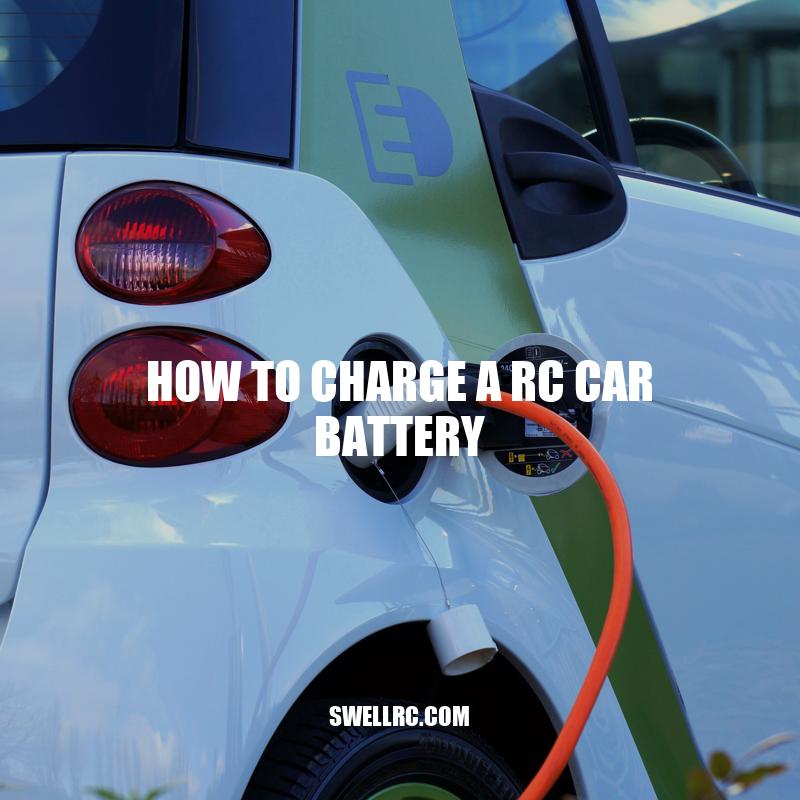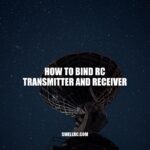RC Car Battery Charging: A Guide to Proper Practice
RC cars are a popular hobby for many people of all ages. They come in many different shapes, sizes, and types, from off-road trucks to on-road speedsters. One thing all RC cars have in common is they run on battery power. As such, a critical element of maintaining an RC car is charging its battery effectively. The proper charging technique will help ensure the battery reaches its full potential, leading to longer run times and better performance on the track or in the street. It’s also essential to choose the right type of charger, as different batteries require different charging tools. Moreover, the safety and longevity of an RC car’s battery depend on the right charging technique. In this article, we will explore how to charge an RC car battery effectively, safely, and efficiently.
Understanding RC Car Batteries
– The two most popular types of batteries used in RC cars are Nickel-Metal Hydride (NiMH) and Lithium Polymer (LiPo) batteries.
– Both types of batteries have their unique charging methods as NiMH batteries can tolerate overcharging, while LiPo batteries require caution.
– NiMH batteries are sturdy, easy to charge, and have a longer lifespan than LiPo batteries, while LiPo batteries are lighter and provide better performance.
– Battery voltage determines the type of charger you need- a 4-cell battery requires a four-cell charger.
– Check the battery’s age and condition before charging to confirm that it is still safe to use.
If you’re not sure what type of battery your car has, refer to the user manual, manufacturer’s website, or a specialized RC website like RC groups, RC Universe, or RC Driver, for guidance. Several online forums and communities offer tips on how to choose the right charger, charge rate, and charging time for a specific type of battery. Some websites even sell charging equipment designed explicitly for RC cars, such as the Traxxas EZ-Peak Plus Charger or the Venom Pro Duo LiPo & NiMH Battery Charger. By doing your research and staying informed, you ensure that you are using the right equipment and taking the right steps to charge your RC car’s battery safely and efficiently.
What are RC car batteries made of?
RC car batteries are typically made of lithium polymer (LiPo) or nickel metal hydride (NiMH). LiPo batteries are the most common choice due to their high energy density and low weight, which allows for longer run times and faster speeds. NiMH batteries are a more affordable option and can be found in lower-end RC cars.
It is important to note that LiPo batteries require special handling and care to prevent damage or even fire hazards. Make sure to read the manufacturer’s instructions and safety tips before using or charging LiPo batteries.
For more information on RC car batteries, visit websites such as hobbyking.com or amainhobbies.com.
Preparing to Charge
– Before you begin charging your RC car battery, ensure you have all the equipment ready.
– Select a clean, dry, and fire-resistant charging space.
– Ensure that the charger and battery are compatible, and they have the appropriate connectors.
– Check the battery’s voltage, capacity, and chemistry, as well as the charge rate of the charger.
– Set the charger to the correct mode for the type of battery you’re using.
Charger Modes for NiMH and LiPo Batteries
| Battery type | Charge mode | Charge rate |
|---|---|---|
| NiMH | Delta peak | 0.5-1C |
| LiPo | Balanced mode | 1C-2C |
– Always follow the manufacturer’s instructions when setting up your charger to prevent overcharging or damaging your battery.
– Do not leave the battery charging unattended, and always use a charging bag for LiPo batteries.
Interesting fact:
Did you know that overcharging is a common cause of battery damage in RC cars? Overcharging can create excess heat, which causes the battery to expand, leak, or catch fire. To prevent overcharging, use a charger with a built-in overcharge protection feature and ensure that you’re using the correct settings for your battery’s chemistry, capacity, and voltage.
If you’re unsure how to prepare your equipment or need more information about the charging process, refer to the manufacturer’s manual, RC forums, or sites like Hobbytronics or Ampow for tips and resources.
Do you need to charge a new battery before use?
Yes, it is recommended that you charge a new battery before using it. This is because most batteries come partially charged from the manufacturer and a full charge is necessary for optimal performance. Additionally, charging a new battery before use can help to condition and prolong its lifespan.
However, it’s important to check the manufacturer’s instructions on charging time and method, as charging times and procedures can vary depending on the type of battery.
Some battery manufacturers may also include specific instructions on how to properly charge and care for their batteries on their websites or product packaging. It’s important to follow these instructions to ensure the longevity and optimal performance of your battery.
Charging an RC Car Battery
– Before connecting the battery to the charger, ensure that the charger is unplugged from the power outlet.
– Identify the positive and negative terminals of the battery and charger.
– Connect the charger to the battery, ensuring that the polarity is correct.
– Connect the charger to the power outlet and turn it on.
Charger Status
– The charger will display the battery’s charging status, such as the current charge level, charging time, and estimated time remaining.
– Some chargers have audible alarms or LED indicators to signal when the battery is fully charged.
Charging Time
– Charging time varies depending on the battery’s specifications and the charge rate of the charger.
– It’s essential to monitor the charging process and avoid overcharging, which can lead to battery damage and safety hazards.
Interesting fact:
Did you know that you can use a smart charger that automates the charging process and optimizes the charging cycle for your battery? Smart chargers offer features like safety shut-off, temperature monitoring, and trickle charging to extend the battery’s lifespan and prevent overcharging. Check out brands like Venom, HTRC, and SkyRC for reliable smart chargers that suit your RC car battery’s needs.
Always follow safety protocols and proper charging procedures when charging your RC car battery. If you’re unsure or experience any issues during the charging process, seek expert advice, or consult RC communities for guidance.
How do you connect a battery charger to a battery?
To connect a battery charger to a battery, follow these steps:
- Consult the owner’s manual of the battery charger and the battery for specific instructions and precautions.
- Make sure both the battery charger and battery are turned off and disconnected from any power source.
- Identify the positive and negative terminals on the battery and the charger.
- Connect the positive charging cable to the positive terminal of the battery.
- Connect the negative charging cable to the negative terminal of the battery.
- Check that the charger is set to the appropriate charging voltage and amperage for the battery.
- Turn on the charger and let it run until the battery is fully charged.
- Turn off the charger and disconnect the charging cables from the battery.
Always follow safety precautions and manufacturer instructions when connecting a battery charger to a battery.
If you’re in search of a high-quality battery charger, check out brands like NOCO, Battery Tender, and Optima on Amazon.
Tips for Proper Charging
- Read the manufacturer’s instructions for the battery and charger before charging.
- Use a charger specifically designed for the type of battery in your RC car.
- Always check the battery and charger for damage or defects before charging.
- Charge batteries at room temperature and on a fireproof surface.
- Never leave a charging battery unattended.
- Remove the battery immediately after charging and disconnect the charger from the power source.
Battery Maintenance
- Regularly clean the battery’s contacts to maintain their connectivity and reduce the risk of damage from corrosion.
- Store the battery in a cool, dry place to prevent moisture and heat damage.
- Never discharge batteries completely, as this can cause irreversible damage to the battery’s cells over time.
Safety Gear
- Wear protective gear like gloves and goggles when handling batteries and chargers.
- Avoid touching the battery’s contacts or charger terminals with bare hands.
- If you experience any adverse reactions or accidents during the charging process, seek medical attention immediately.
Don’t forget to check online resources like RC forums, manufacturer websites, and Amazon products for helpful tips, reviews, and tutorials on RC car battery charging and maintenance. Remember, proper charging habits and battery maintenance can extend your battery’s lifespan and keep your RC car running smoothly.
Is Charging to 85% Better?
- It prolongs battery life if charging sessions are kept within an 80% to 30% range.
- Charging to 100% can lead to faster battery depletion and generate more heat.
- However, occasional, full 100% charges can help recalibrate the battery indicator.
- It varies for each device and manufacturer, so check the specifications of your device for optimal charging methods.
Safety Precautions
Charging an RC car battery can be dangerous if proper safety precautions are not taken. Here are some essential precautions to keep in mind:
Charger Safety
- Use a charger that is designed specifically for RC car batteries and follow the manufacturer’s instructions.
- Ensure that the charger is unplugged from the electrical outlet before you connect or disconnect the battery.
- Keep the charger away from water and other liquids to avoid electrical shock.
Battery Safety
- Avoid charging damaged batteries as they can release toxic gases and become a fire hazard.
- Never allow the battery to overheat, and stop charging if the battery becomes hot.
- Keep batteries away from flammable materials and avoid charging them on combustible surfaces.
Fire Safety
- Have a fire extinguisher nearby while charging batteries.
- Never charge batteries near items that can catch fire, such as gasoline or aerosol cans.
- In case of fire, immediately unplug the charger and safely remove the battery from the area.
By following these safety precautions, you can reduce the risks associated with charging an RC car battery. Always exercise caution and keep safety in mind during every step of the charging process. For more information on battery safety, visit the RC Car Action website or your battery manufacturer’s website.
How Can You Be Safe Around Batteries?
– Always read the manufacturer’s instructions for safe handling and disposal of batteries.
– Keep batteries out of reach of children and pets to prevent accidental ingestion.
– Do not mix different types of batteries or new and used batteries in the same device.
– Do not store batteries in extreme temperatures or direct sunlight.
– If a battery becomes damaged or leaks, dispose of it properly and do not touch the leaked materials with bare hands.
For more information on battery safety, visit the website of the Battery Council International or the Consumer Product Safety Commission.
Conclusion
Properly charging your RC car battery is crucial to ensuring that your car performs at its best and lasts for a long time. By familiarizing yourself with the different types of batteries and chargers, as well as following proper safety precautions, you can keep your RC car running smoothly and avoid the risks of potential accidents.
It is essential to always read the manufacturer’s instructions before charging your battery, as well as using a charger specifically made for your RC car battery. Always charge in a safe, proper location and never leave your battery charging unattended. By following these simple steps, you can keep your RC car batteries charged and ready for play.
Finally, if you are interested in expanding your knowledge of RC cars, there are many websites and forums where you can find additional information on battery maintenance, car upgrades, and more. Keep learning and enjoy the thrill of running your RC car!



